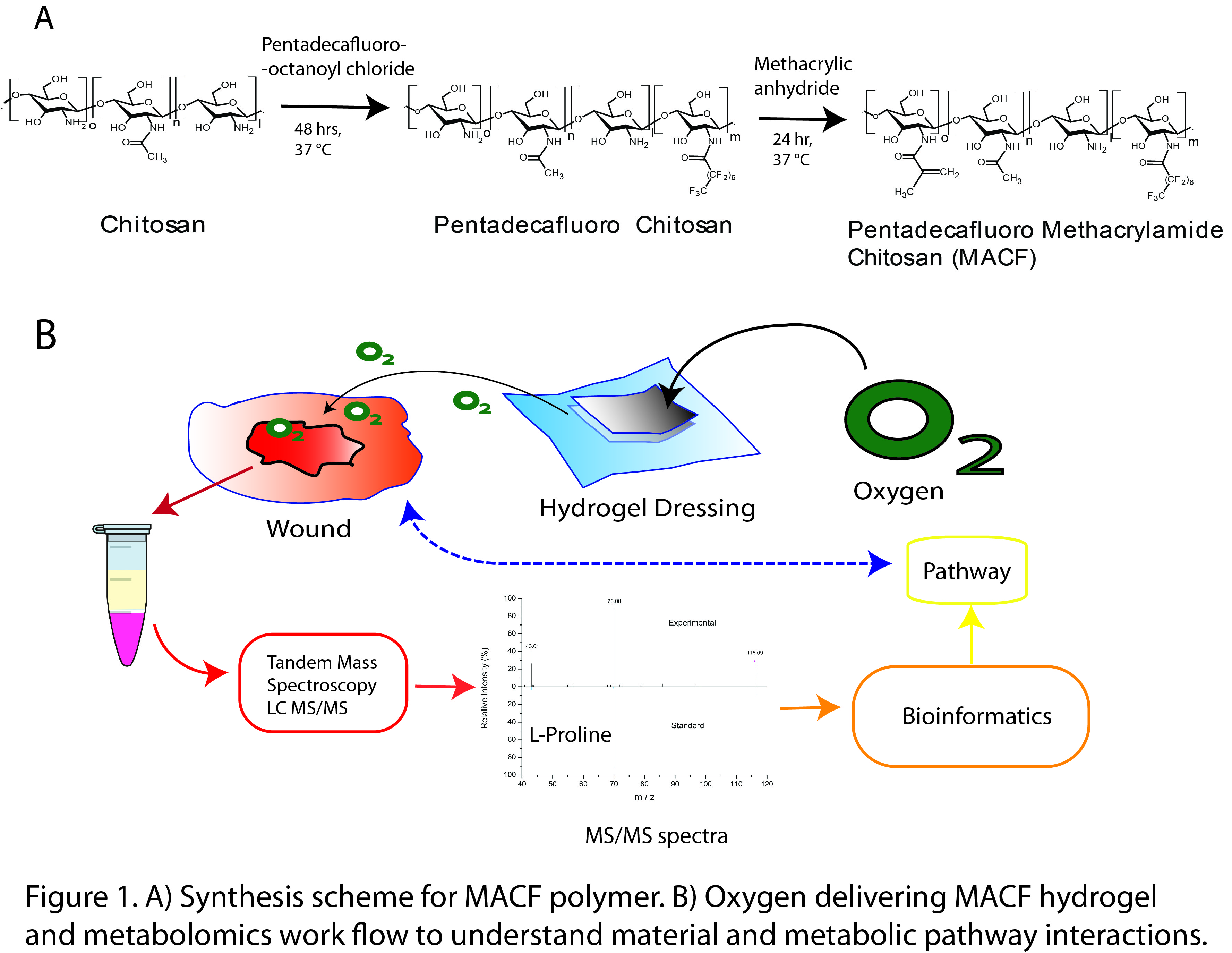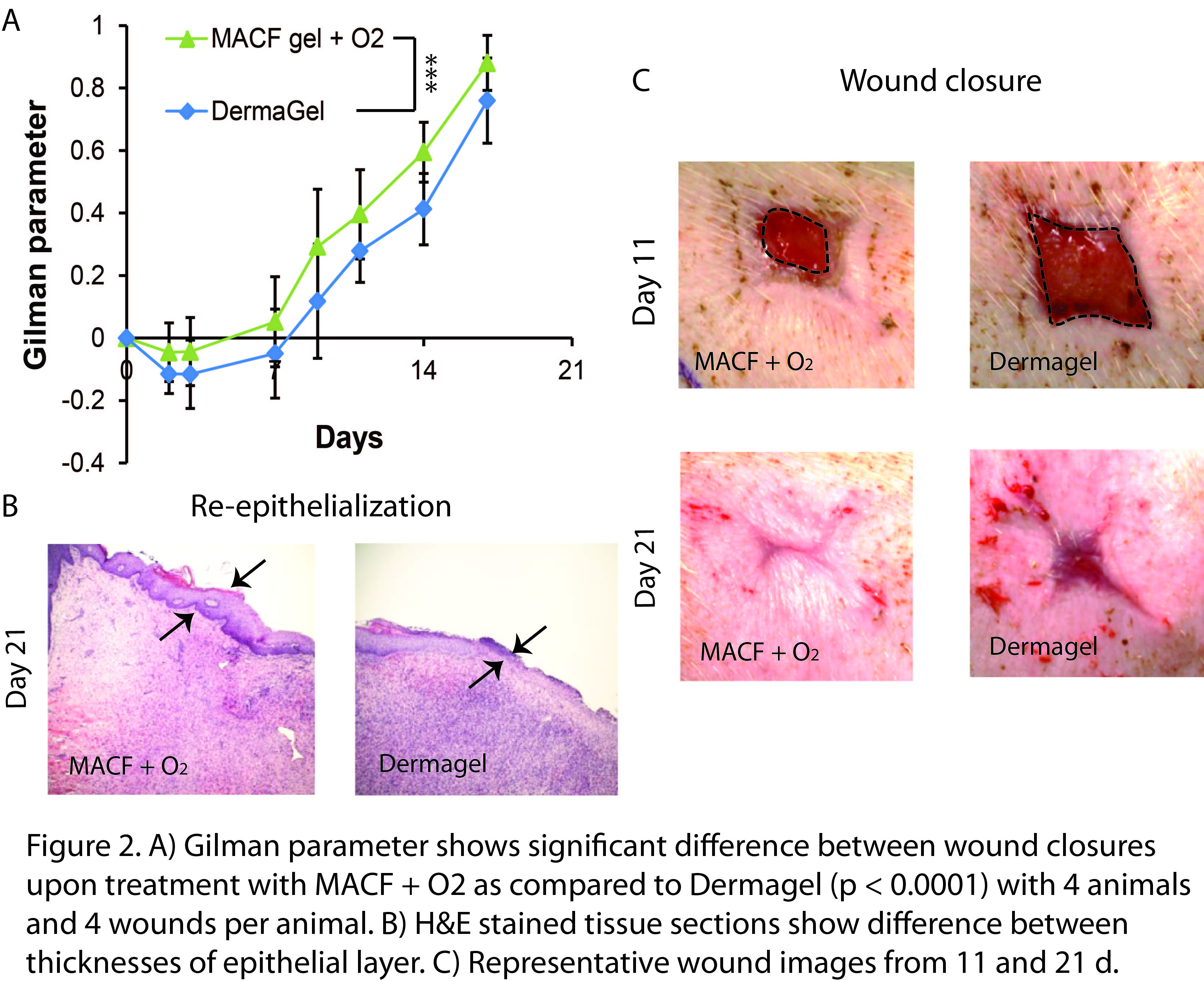Introduction: Oxygen plays an essential role in wound healing; however, current oxygen therapies are inadequate. We have created a unique functionalized hydrogel that imparts the ability to enhance oxygenation. The overall goal was to evaluate our hydrogel in a porcine wound model and to understand metabolic changes using metabolomics. We hypothesize that MACF hydrogels will deliver beneficial levels of oxygen when applied in vivo on wounds and accelerate wound healing responses.
Methods: Pentadecafluoro methacrylamide chitosan (MACF) was synthesized (Fig. 1A) with a scaled up synthesis process. Hydrogels were formed by photo-polymerization, washed and then shrunk to allow for tuned swelling in the wound.

Oxygen release and swelling studies were performed using hydrogels. After establishing hydrogel scaffolds in-vitro, we tested gels in a full thickness excisional porcine wound model. We used four groups: MACF + O2 (oxygenated), MACF atm (non-oxygenated), Dermagel™ (standard of care), and no hydrogel treatment; all covered by a secondary foam dressing. Wounds were photographed and dressings were changed every 2-4 d until day 21. At 14 and 21 d, wound tissue biopsies went to metabolomics analysis or were fixed for histology. Fixed samples were paraffin embedded and sectioned. H&E and Masson’s trichrome were performed. Keratins, von-willebrand factor, and Ki67 IHC staining was done to understand maturation of epithelial layer, vascularization of a tissue and cell proliferation. For metabolomics, digested tissue extracts were run through TripleTOF mass spectrometer (AB SCIEX)[1] to characterize the secretome at 14 and 21 d (Fig. 1B). Bioinformatics of the metabolomics results is currently being performed.
Results and Discussion: We have successfully shown that MACF hydrogels sustain delivery of oxygen up to 5 d in vitro[2]. In this study we created larger clinically relevant hydrogel dressings (2.5 x 2.5 cm) that delivered oxygen and stayed in place with minimal swelling on pigs for the 2-4 d period. Gilman results show significantly faster closure for MACF as compared to Dermagel™ (p<0.0001; Fig. 2A).

Histological analyses revealed enhanced re-epithelialization supporting the benefits of local oxygen delivery from MACF + O2 hydrogels (Fig. 2B). Metabolomics bioinformatics is in process, and we expect a similar pipeline as in our rat excisional wound model study where we saw significantly different metabolic profiles for our treatment versus controls (p<0.05). This included changes in key metabolites related to wound healing specific collagen synthesis and inflammation due to our MACF treatment.
Conclusions: Our results show important benefits of oxygen delivery to a wound through MACF hydrogels, with enhanced wound healing in a full thickness excisional pig model. Excitingly, we have also explored the potential of metabolomics for understanding and revealing underlying key pathways that are positively altered by interaction with biomaterials.
Judith A. Fulton
References:
[1] Pritam S. Patil NF-D, He Huang, M. Michelle Evancho-Chapman, Judith A. Fulton, Leah P. Shriver, Nic .D Leipzig. Fluorinated Methacrylamide Chitosan Hydrogels Enhance Collagen Synthesis in Wound Healing through Increased Oxygen Availability. Submitted. 2015.
[2] Wijekoon A, Fountas-Davis N, Leipzig ND. Fluorinated methacrylamide chitosan hydrogel systems as adaptable oxygen carriers for wound healing. Acta biomaterialia. 2013;9:5653-64.